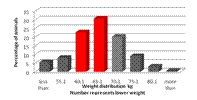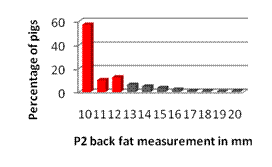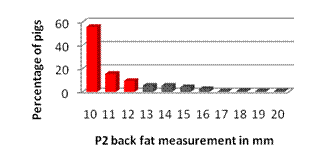My pigs are too fat an
investigation process
|
1 |
Define the problem |
||||||||
|
Look at backfat over time check for seasonal impact The P2 changes with the time of the year pigs are fatter going into autumn as they eat more as the weather cools off and they are thinner in the early summer as they grow better. Note the effect is also on the weaners growth and fat deposition |
|
||||||||
|
Look at back fat variation
within the group of pigs what is the required matrix |
|||||||||
|
|
|
||||||||
|
The green box represents the ideal
matrix box. At this slaughterhouse the ideal
matrix was 8 to 12 mm and 60 to 70 kg deadweight The two graphs are the range of
weights presented in the slaughterhouse and the P2 measurements in those pigs |
|||||||||
|
In this population: Mean deadweight (headoff) 67.3 kg sd 7.3 Backfat P2 10.4 mm sd 2.82 |
|||||||||
|
2 |
What effect on back fat, and
more importantly profit, if you change some parameters |
||||||||
|
Check the result of the population if: Change in average weight up and down Sell pork or light weight pigs more efficiently (if this is available) Decrease variation around the ideal point: Raise the light pigs give them an additional week Decrease number of heavy pigs weigh pigs Pigs should be weighed every time they are moved weaning/10 weeks and slaughter at least Decrease the variation in back fat note and sell heavy fat pigs, Paylean and PST Increasing live weight at slaughter by 1 kg increases P2 by 0.2 mm Note impact of chemicals Paylean, PST or Improvac (for males) for example (if available) |
|||||||||
|
3 |
When is the problem occurring-
examine the growth rate of the pigs |
||||||||
|
|
Fat deposition is about feed intake, but this can be difficult to measure. Monitor the growth rates of the pigs at various stages around the farm. Pigs who grow slower in the nursery area will not deposit lean tissue. Pigs that reduce their feed intake in the finishing house will be leaner. |
||||||||
|
Days to
slaughter = ((Total
wean to finish pigs on the farm/pigs sold each week)+(weaning age in
weeks)*7) Growth
rate = (Liveweight
kg)/(days to finish) = g/day birth to finish |
|||||||||
|
4 |
What is the spread of ages at slaugther? |
||||||||
|
|
How tight is the slaughterhouse
weights and how long does it take for the farm to empty the finishing
house? Does the farm utilise a weigh
scale to monitor liveweight. Note diseases present |
||||||||
|
5 |
Environment of the pigs |
||||||||
|
These pigs are exactly the same genetics as in point 2. Here the pigs were housed on straw |
|||||||||
|
|
|
||||||||
|
As pigs are raised more controlled
environments the backfat range and variation reduces. These pigs on straw had a deadweight
(head off) mean weight 72.2kg sd 7.1, P2 11.8 mm sd 3.5 But note heavier pigs have more
backfat. These extra 5 kg would be
expected to raise P2 by 1mm. |
|||||||||
|
|
|
||||||||
|
The pigs from point 2 slatted
curtain sided |
The pigs from point 4 ecoshelter on straw |
||||||||
|
Are any provisions made for the small pigs at weaning streaming. This helps to reduce variation |
|||||||||
|
6 |
Impact of sex male, female or castrates |
||||||||
|
Male on improvac |
Female |
||||||||
|
|
|
||||||||
|
Deadweight kg mean 68.6kg backfat P2
10.5mm |
Deadweight kg mean 66.4kg backfat P2
10.4mm |
||||||||
|
7 |
Basic production issues pig flow |
||||||||
|
All farms batch. What are the batch parameters being utilised/required? Does the farm utilise all-in/all-out? Monitor batch variations over the year look for under-stocking and over-stocking |
|||||||||
|
8 |
Feed factors |
||||||||
|
Examine the feed and feed
quality |
Increasing
lysine by 1g per day reduces back fat 0.1 mm Increase
protein intake in general but this increases cost Increase energy
intake by 1MJ/DE per day increase fat depths by -0.6 mm Reduce feed intake 100g per day decrease P2 by 0.6mm. |
||||||||
|
Note mycotoxins
and other factors that impact feed intake |
Carefully examine feeders and waterer. Space and location within the pen |
||||||||
|
9 |
Environmental factors |
High conformation boar |
|||||||
|
Check the environment of the various
accommodation. When are the pigs moved? |
Note Water,
Food,
Floor
and Air
issues. Are facilities
suitable for the group note over and under-stocking |
||||||||
|
10 |
Genetic factors |
||||||||
|
The boar
in particular can have an enormous impact on feed intake, backfat, carcase
composition and growth rates. |
But note:- the mother also provides half of the genetics to the finishing pig. This can be a particular problem in home reared gilts. |
||||||||
|
Some clients with homebred boars will use a selection of boars on test sows. The boars are then put on ice. Following a review of the ofspring in the slaughterhouse 9 months later the best boar is brought out of retirement for the next year the others sold |
|||||||||
|
11 |
Diseases and pathogens |
||||||||
|
Examine the pigs for any pathogen
which is going to increase variation and affect feed intakes. Ileitis
(porcine enteropathy), lameness
issues, respiratory
problems. Note Mycoplasma pneumonia may actually
reduce P2 by limiting feed intake in the finishing pig! |
|||||||||












